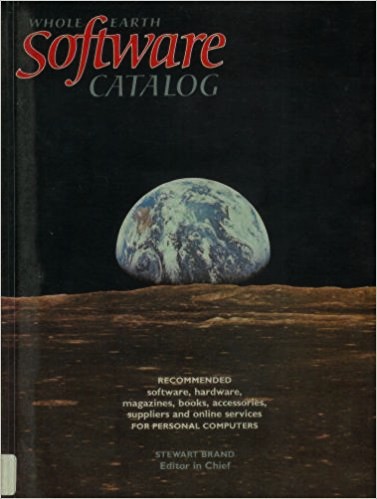
by Christopher Lehmann-Haupt, New York Times, 3 October 1984 - https://www.nytimes.com/1984/10/03/books/books-of-the-times-243641.html

WHOLE EARTH SOFTWARE CATALOG.
Stewart Brand, editor in chief.
208 pages. Illustrated.
Quantum/Doubleday. $17.50.
YES, it's true that Stewart Brand received a $1.3 million advance to produce the Whole Earth Software Catalog. With typical and becoming candor, Mr. Brand not only confirms the fact in these pages, but reveals where the money went, as well as how many copies of the Catalog will have to be sold - 540,000 - "before we see any income beyond the advance." As Mr. Brand concludes, the advantage to the reader of Doubleday's handsome advance going to Mr. Brand's nonprofit foundation called Point "is that all of the money was to work on the research and publications; nobody got rich."
Nobody got rich financially, that is. Any reader who reads the Catalog will get rich in computer information. It was brilliantly logical of Doubleday to underwrite Stewart Brand. As the founder and editor of The Whole Earth Catalog and its various permutations, Mr. Brand is an expert on tools, and, as he says in his Introduction to the present catalogue, computers are such effective tools that with the advent of "personal computers came a shift in the power balance" between individuals and institutions.
"It may be that more accumulated code is stirring in the interests of individuals now than in the interests of institutions," he writes, meaning, I assume, that the total lineage of programs for personal computers now exceeds what mainframes are using, which is surprising but plausible. "It may be that more significant invention is coming from the hands of individuals," he continues. "That's news that stays news, and good news at that. But there's a hilarious obstacle. For new computer users these days the most daunting task is not learning how to use the machine but shopping. Hence this book."So the Catalog is above all a shopping guide, telling us what to buy in the way of hardware, software, books, magazines and related products and services; telling us where to buy them and how. It divides up the world of computer skills into Playing, Writing, Analyzing, Organizing, Accounting, Managing, Drawing, Telecommunicating, Learning and "Et Cetera." In each section, a "domain editor" records his own and other experts reactions to the various products. All together, over 400 items are reviewed and recommended. The Catalog will be updated yearly, and in the intervals will be supported by a quarterly magazine, the Whole Earth Software Review, which is shamelessly recommended in these pages and has already appeared in three issues.
I believe a novice could learn from these pages what a computer is. But the greater appeal is to what might be called the computer hedgehog - the person who knows only one machine, or one activity, or one set of programs. That defines most of us. An adage in computing holds that people swear by whatever they learn first, no matter how unwieldy it may turn out to be in the larger scheme of things. We move in burrows. Apple users meet only other Apple users. IBM PCniks learn more and more about the IBM PC.
The exciting thing about the Whole Earth Software Catalog is that a processor of words can learn what a spreadsheet is, or a Data Base Management System, or CAD - Computer-Aided Design. I grew so intoxicated by my browsing that I found myself desperately wanting a dozen programs I couldn't possibly find a practical use for - Open Access, for example, which permits you to project three-dimensional graphs, among other things; or Easel, which for $2,500 allows you paint on screen with 16-million colors, 4,096 of them simultaneously.
After a while, I forgot the catalogue's soundest piece of advice, which is to "acquire as little software as you can get by with, and stick with it." As Mr. Brand continues: "It's easy to get so caught up in the constant rush of improvements and 'next generations' in the software market that you wind up forever getting ready to work instead of working." Right!
But this catalogue is not entirely helpful in that respect, with its color reproduction of Flight Simulator, a program that puts you at the controls of an airplane, or its praise of computer games as the ideal in "self-evident" program design. "Elements that you will find in business application programs years from now," writes Mr. Brand, "are evolving in bright colors before your eyes in software like PINBALL CONSTRUCTION SET (p. 36) and CHOPLIFTER! (p. 35)."
I even began to regret my marriage to a Kaypro, with its monochrome screen and an 8-bit operating system for which not all that many programs are being written any more. Maybe my children could use an IBM PCjr, or at least a Commodore 64, I began to speculate. Would a digitizing tablet, for doing precision graphics, be tax deductible?
I almost came to my senses when I got to the final page of the catalogue and was reminded that the "workhorse" for producing this book was - what else? - a Kaypro. For the moment I felt satisfied with my lot. But the raptures of the deep began to lure me again. I need a KoalaPad, for drawing with a stylus or my finger, and a new computer to run it on. I need Moviemaker, Real Estate Consultant, The Master Builder, and The Desk Organizer. I could use Master Tax Planner, Thinktank (for organizing one's thoughts), Winning on Wall Street, and Julius Irving & Larry Bird Go One on One. I really need these things. Who says computing is a tool? I say it's an end in itself - quantified narcissism disguised as productive activity.